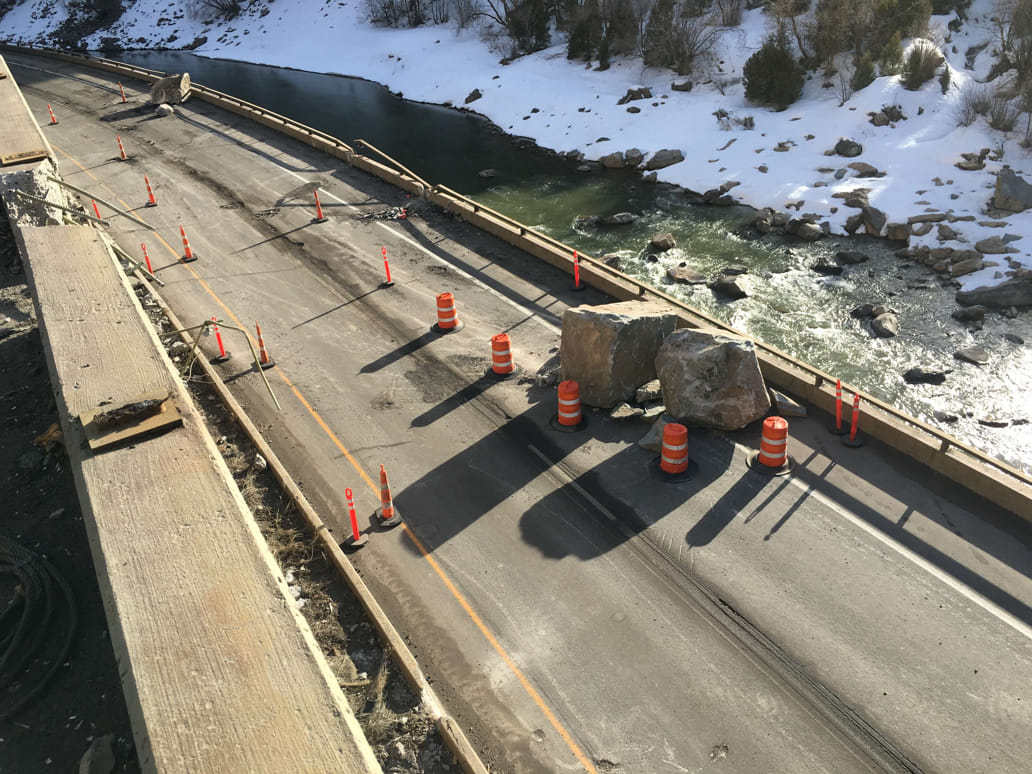



Rockfalls present a serious and continuous hazard for any properties or infrastructure below the unstable mass. Rockfall events can occur for many reasons, including:
Most rockfalls occur after earthquakes, which result in large boulders falling, bouncing, and dislodging further rocks, resulting in extremely hazardous conditions below.
At GeoStabilization International®, our structural engineers, geotechnical specialists, and Rockfall Remediation Technicians provide some of the finest expertise in the United States to address rockslides and ensure safety and stability of rockfaces such as cliffs and hillsides, especially those that threaten highways or buildings below.
While in some cases, rockfalls are a once-off event, in other instances, they present a continuous hazard that requires mitigation and stabilization. A geological survey can help states and other governing bodies determine whether a potentially unstable rockface requires the intervention of a rockfall mitigation company such as ours at GeoStabilization International®. Our company uses several techniques to address rockfall hazards and will choose the method most suitable to provide a rapid and cost-effective solution.
Rock scaling refers to removing loose and potentially unstable, disjointed rocks from a slope, dirt, brush, and trees. Generally, rock scaling is the first step in a more comprehensive rockfall mitigation strategy, but in some instances, it may be sufficient to stabilize a rockface by itself.
Rock bolting is a long-term stabilization strategy through which a steel rock bolt drilled into the rock formation provides support for the entire rock face. Rock bolt spacing and depth depend heavily on the reinforcement requirements, and engineers must strike a balance between cost and safety.
A drape mesh catches deteriorating rocks before they can cause damage to infrastructure and diverts them to a dedicated containment area. In addition, the mesh provides long-term protection in cases where rock scaling and rock bolting are insufficient.
Rockfall hazards become increasingly common and severe as roads and urban areas expand into mountainous regions. High-energy rockfall fences catch falling debris before it can affect these developing areas while remaining ecologically sound and preserving the aesthetic beauty of the mountainside.
A rockfall event in the Rocky Mountains blocked a heavily traveled section of Interstate 70 in Colorado when a large boulder fell onto the westbound lane, destroying the guardrail and landing on the eastbound lane below. Subsequent rockslides left large boulders almost entirely blocking the interstate and endangering motorists, some boulders coming to rest on a semi-trailer. The rockslide closed the highway and forced over 300 travelers per hour to take a nearly 150-mile detour around the adjacent canyon.
The State of Colorado contracted GeoStabilization International® to stabilize the steep hillside above the highway. The client’s geohazard program managers determined that the mass of destabilized rock was still active and endangering the interstate below with a high potential for subsequent landslides and rockfall incidents. The situation required immediate remediation and mitigation.
Our skilled Rockfall Remediation Technicians (RRTs) from GeoStabilization International® traveled by helicopter to the mountain above the interstate and started rock scaling to remove as much loose, unstable rock as possible. This enabled Colorado DOT highway repair teams to begin reconstruction and restorations on the damaged I-70 highway structure. During the process, our company worked with IDS, which deployed a radar monitoring system to observe the rock mass and report any destabilization to the highway repair teams below. Once the slope was initially scaled to remove any remaining unstable boulders, CDOT was able to progressively reopen the lanes of traffic to the traveling public. Despite snowy conditions, limited road access was restored in less than a week with lanes in both directions, and finally opening days after.
By working closely with an experienced rockfall mitigation company, the Colorado DOT could progressively reopen the highway and avoid further incidents. According to project specifications, no further intervention was necessary, and the highway remains free from subsequent rockfall events.
For more information about GeoStabilization International® and our rockfall mitigation projects, call us at 855-579-0536 today! We provide services throughout the United States, Canada and Australasia.
If you are interested in a no-obligation site visit to determine if our services fit your geohazard mitigation needs, call us at 855-579-0536 or fill out our contact form.